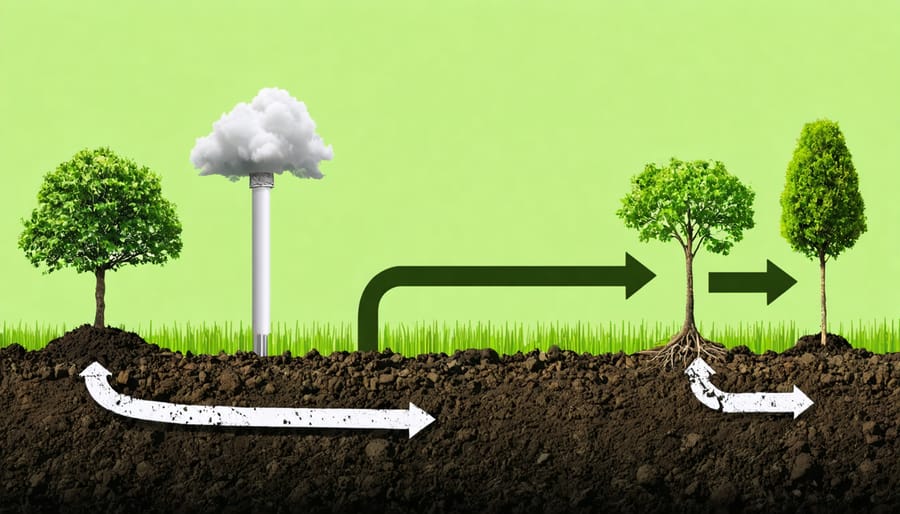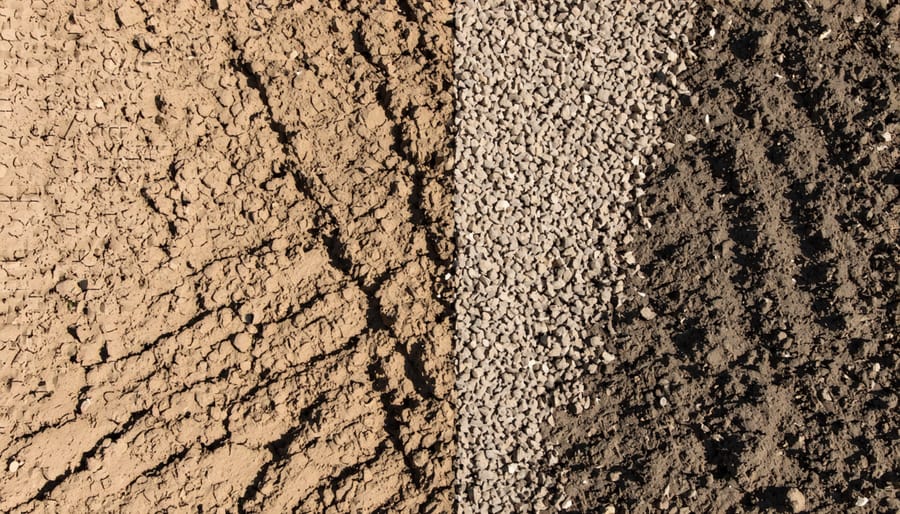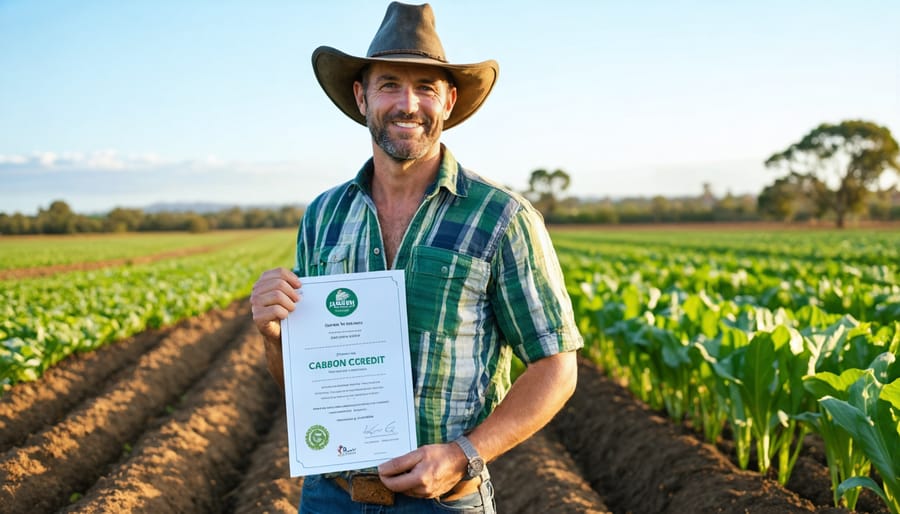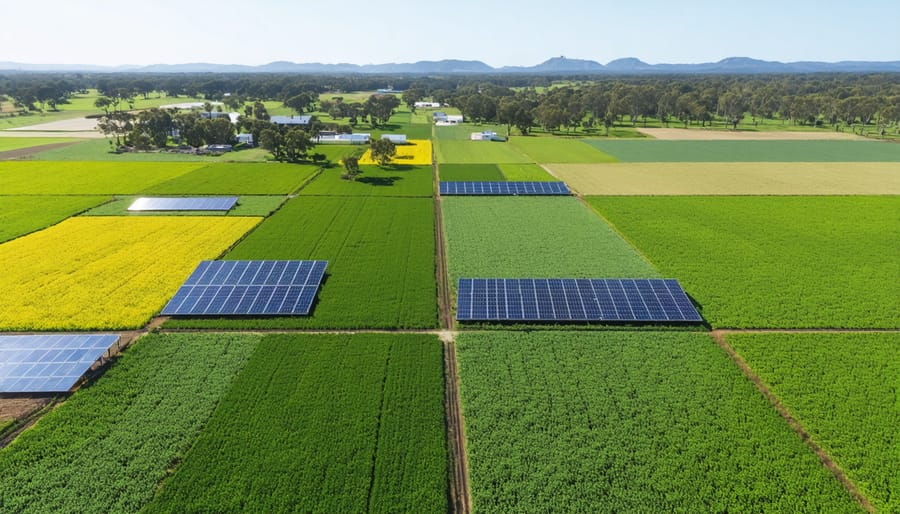Australian farmers are pioneering a global agricultural revolution by unlocking their soil’s carbon-fighting potential, transforming traditional farming practices into powerful weapons against climate change. Through innovative carbon sequestration techniques, agricultural lands now capture and store millions of tonnes of atmospheric carbon dioxide annually, offering a practical solution to one of humanity’s most pressing challenges.
This natural process not only helps combat global warming but also improves soil health, increases crop yields, and creates new income streams for farmers through carbon credits. By implementing methods like cover cropping, minimal tillage, and strategic grazing management, Australian agricultural operations are demonstrating how working landscapes can become vital carbon sinks while maintaining productive food systems.
The science is clear: agricultural soils can store more carbon than all the world’s forests combined. As global markets increasingly value carbon sequestration, Australian farmers are positioning themselves at the forefront of this environmental and economic opportunity, proving that sustainable agriculture and climate action can work hand in hand to create a more resilient future.
How Australian Soil Becomes a Carbon Vault
The Carbon Capture Process
Plants are remarkable natural carbon sequestration systems, working tirelessly to help combat climate change. Through photosynthesis, they absorb carbon dioxide from the atmosphere, converting it into glucose and other organic compounds essential for growth. This process effectively locks carbon away in plant tissues, from roots to leaves.
But the real magic happens below ground. As plants grow and eventually die, their organic matter becomes incorporated into the soil. Root systems play a crucial role, releasing carbon-rich compounds that feed beneficial soil microorganisms. These tiny workers transform plant matter into stable forms of soil carbon, known as humus, which can remain stored for hundreds or even thousands of years.
In healthy agricultural soils, this carbon storage process is continuously cycling. Living plants pump carbon into the soil through their roots, while soil organisms break down dead plant material, creating a rich, carbon-filled ecosystem. This natural process not only helps fight climate change but also improves soil health, water retention, and crop productivity – a true win-win for Australian farmers and the environment.

Measuring Success in the Soil
Measuring success in agricultural carbon sequestration requires a combination of traditional soil testing and cutting-edge technology. Australian farmers are increasingly using soil organic carbon (SOC) testing, which involves collecting samples at various depths and locations across their properties. These samples undergo laboratory analysis to determine carbon content and density.
Modern monitoring methods now include satellite imagery and drone technology to track changes in vegetation cover and soil health over time. Farmers can access user-friendly digital platforms that compile this data, creating detailed carbon storage maps of their land.
The Carbon Farming Initiative has established robust measurement protocols, requiring farmers to document their practices and demonstrate consistent carbon improvements. Soil probes equipped with sensors provide real-time data on moisture levels, temperature, and organic matter content, helping farmers optimise their sequestration efforts.
Success is typically measured over 3-5 year periods, with many Australian farmers reporting increases of 0.5-2% in soil organic carbon levels. These improvements not only contribute to carbon credits but also serve as indicators of overall soil health and agricultural productivity.
Proven Practices That Lock Carbon in Your Soil
No-Till Farming
No-till farming has emerged as a game-changing practice in agricultural carbon sequestration, offering significant benefits for both farmers and the environment. By leaving the soil undisturbed between harvests, this method preserves valuable organic matter and maintains crucial soil structure. Instead of traditional ploughing, farmers plant directly into the previous crop’s residue, creating a natural protective layer that shields the soil.
This approach dramatically reduces soil erosion, with many Australian farmers reporting up to 90% less soil loss compared to conventional tillage. The preserved organic matter acts like a sponge, improving water retention and reducing irrigation needs – a crucial advantage in our drought-prone climate. Additionally, undisturbed soil hosts a thriving ecosystem of beneficial organisms, from earthworms to microscopic fungi, which naturally enhance soil fertility.
The implementation of no-till farming requires initial investment in specialized equipment and careful planning, but the long-term benefits are substantial. Many Australian farmers have found that no-till practices not only increase their soil’s carbon storage capacity but also reduce fuel costs and labour requirements, making it a win-win solution for both environmental and economic sustainability.

Cover Cropping
Cover cropping stands out as one of the most effective practices for enhancing soil carbon sequestration in Australian agriculture. By planting specific crops during off-seasons or between main crop rotations, farmers can significantly boost their soil’s carbon content while improving overall soil health.
Popular cover crops in Australia include legumes like clover and vetch, which not only capture carbon but also fix nitrogen in the soil. Cereal crops such as oats and rye are equally valuable, developing extensive root systems that contribute to long-term carbon storage.
The beauty of cover cropping lies in its multiple benefits. Beyond carbon sequestration, these crops prevent soil erosion, suppress weeds, and enhance biodiversity. Many Australian farmers report improved water retention and reduced fertiliser needs after implementing cover cropping systems.
For optimal results, timing is crucial. Planting cover crops immediately after harvesting the main crop ensures maximum growth and carbon capture potential. Modern no-till seeding techniques make it easier than ever to integrate cover crops into existing farming operations, creating a win-win situation for both the environment and farm productivity.
Crop Rotation
Crop rotation stands as one of the most effective natural methods for enhancing soil carbon storage while maintaining soil health. By strategically alternating different crops across seasons, farmers can maximise carbon sequestration while improving their land’s productivity.
The most successful rotation patterns typically include a mix of deep-rooted perennials and seasonal crops. For instance, many Australian farmers alternate between wheat crops and nitrogen-fixing legumes like lupins or field peas. This combination not only stores carbon deep in the soil profile but also naturally enriches soil fertility.
Including cover crops during fallow periods proves particularly effective for carbon storage. Fast-growing species like oats, rye, or forage sorghum protect the soil while pumping carbon into it through their root systems. Many forward-thinking farmers are now incorporating native Australian species into their rotation schedules, as these plants are naturally adapted to local conditions and can significantly boost carbon storage capacity.
Best results come from three to four-year rotation cycles, allowing sufficient time for soil organic matter to build up between different crop phases. This approach has shown to increase soil carbon levels by up to 15% in some Australian farming operations while reducing the need for synthetic fertilisers.
Organic Matter Management
Effective organic matter management is a cornerstone of agricultural carbon sequestration, offering farmers practical ways to boost soil carbon levels while improving farm productivity. Cover cropping stands out as a powerful technique, where crops like legumes and cereals are planted between main growing seasons to protect and enrich the soil. These plants add valuable organic material when incorporated back into the earth.
Crop residue management is another vital practice, where stubble and plant remains are retained rather than burned or removed. This approach not only returns carbon to the soil but also helps retain moisture and prevent erosion. Many Australian farmers have found success with strategic composting, turning farm waste into nutrient-rich soil amendments that boost organic matter levels.
Rotational grazing has proven particularly effective in our rangelands, where carefully managed livestock movements help stimulate plant growth and root development, naturally increasing soil organic matter. When combined with minimal tillage practices, these methods create a powerful system for building soil carbon while maintaining productive agricultural operations.
The key is to adopt a holistic approach, choosing techniques that suit your specific farming context and local conditions.
Carbon Credits: Making Soil Storage Pay
Australian Carbon Credit Units
Australian farmers can now actively participate in Australia’s climate action initiatives through the Australian Carbon Credit Units (ACCUs) system. This innovative program rewards landholders for implementing practices that reduce greenhouse gas emissions or sequester carbon in their soil and vegetation.
For every tonne of carbon dioxide equivalent that farmers successfully sequester or avoid emitting, they earn one ACCU. These credits can then be sold to businesses, governments, or other entities looking to offset their emissions, creating a valuable additional income stream for agricultural producers.
To participate, farmers must register their carbon farming project with the Clean Energy Regulator and follow approved methodologies. These might include activities such as improving soil carbon levels, establishing environmental plantings, or managing savanna burning. The process involves initial baseline measurements, ongoing monitoring, and regular reporting to ensure the credibility of carbon reductions.
Success stories from early adopters show promising results. Many farmers have found that carbon farming practices not only generate ACCUs but also improve soil health, increase productivity, and enhance farm resilience. The system provides a win-win situation where agricultural producers can contribute to climate solutions while diversifying their income sources.
For those interested in getting started, the Clean Energy Regulator offers comprehensive guidance and support, making it easier for farmers to navigate the registration and compliance requirements.
Getting Started with Carbon Trading
Getting started with carbon trading might seem daunting, but Australian farmers have several straightforward pathways to enter this growing market. The first step is to assess your property’s carbon sequestration potential through a baseline soil carbon measurement. This involves working with accredited soil testing laboratories to determine your current carbon levels.
Next, register your interest with the Clean Energy Regulator and choose an approved carbon farming methodology. Popular options include soil carbon storage, environmental plantings, and sustainable grazing management. You’ll need to partner with a registered carbon service provider who can guide you through project development and documentation.
Implementation begins with developing a carbon farming plan that outlines your chosen practices, such as minimum tillage, cover cropping, or rotational grazing. Keep detailed records of your activities and changes in land management practices, as these will be crucial for verification.
To monetise your efforts, you can sell Australian Carbon Credit Units (ACCUs) through various channels. These include direct contracts with buyers, carbon trading platforms, or through aggregators who bundle credits from multiple farms. Many successful farmers start small and scale up their carbon projects as they gain experience.
Remember that carbon farming is a long-term commitment, typically requiring project periods of 25 years or more. However, the benefits extend beyond carbon credits to include improved soil health, increased productivity, and enhanced farm resilience.

Real Success Stories from Australian Farms
The Thompson family farm in Victoria’s Goulburn Valley stands as a shining example of successful carbon farming. Over the past five years, they’ve transformed their 2,000-hectare property by implementing strategic crop rotation and minimal tillage practices. Their soil organic carbon levels have increased by 2%, resulting in improved water retention and crop yields while sequestering an estimated 10,000 tonnes of CO2 equivalent.
In Western Australia’s wheatbelt, the Robertson brothers have pioneered an innovative approach combining native vegetation corridors with precision agriculture. Their ‘carbon corridors’ not only serve as wildlife highways but have also helped them earn carbon credits through the Emissions Reduction Fund, providing an additional revenue stream of $50,000 annually.
The McLaren Vale wine region in South Australia showcases how even smaller operations can make a significant impact. The Collins Vineyard adopted cover cropping and composting practices, leading to a 30% reduction in synthetic fertilizer use while improving soil health. Their wines now command premium prices, with buyers specifically seeking out their carbon-conscious production methods.
Perhaps most impressive is the transformation of the drought-prone Hayes cattle station in Queensland. By implementing rotational grazing and establishing deep-rooted perennial grasses, the Hayes family has increased their soil carbon content while improving drought resilience. Their success has inspired neighbouring properties to adopt similar practices, creating a ripple effect across the region.
These success stories demonstrate that carbon sequestration isn’t just about environmental benefits – it’s creating real economic advantages for Australian farmers. From improved soil fertility and water retention to additional income through carbon credits, these pioneering farmers are showing that sustainable agriculture and profitable farming go hand in hand.
Their achievements have not gone unnoticed, with several farms now hosting regular field days to share their knowledge and experiences with other farmers looking to begin their carbon farming journey.
Agricultural carbon sequestration represents one of our most powerful tools in the fight against climate change, offering a win-win solution for farmers and the environment. Through the adoption of proven carbon-fighting strategies, Australian farmers are not only improving soil health and productivity but also creating new revenue streams through carbon credit markets.
The benefits extend far beyond the farm gate. Enhanced soil carbon levels lead to better water retention, reduced erosion, and improved crop yields, creating more resilient agricultural systems in the face of climate challenges. These practices also support biodiversity, protect wildlife habitats, and contribute to cleaner waterways.
As we’ve seen through numerous success stories across the country, from regenerative grazing in Queensland to cover cropping in Victoria, the transition to carbon-smart farming is both achievable and profitable. The time to act is now, with increasing support from government initiatives, carbon markets, and agricultural extension services.
By embracing these sustainable practices, we’re not just securing the future of Australian agriculture – we’re playing a crucial role in global climate action. Every hectare converted to carbon-smart farming brings us closer to our emissions reduction goals while building a more sustainable and profitable agricultural sector for future generations. Let’s work together to make carbon sequestration a standard practice in Australian agriculture, creating a legacy of environmental stewardship and economic prosperity.

